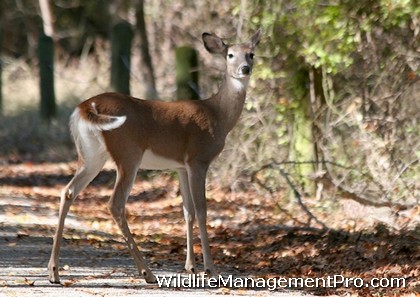White-tailed deer are a popular in Texas, but they are not necessarily popular with everyone. Although beautiful animals, deer should always be respected. Folks that live in the urban areas of Central Texas know this all too well. Many communities have faced the realities of urban deer management; attempts to control increasing deer populations in the face of a growing human population. Take the Georgetown area, for example:
“A white-tailed doe, grazing in a lush green yard, hears a noise. Her head pops up. She stares, turning into a momentary statue. Suddenly, she darts across the yard toward the nearest bunch of trees, leaping over the fence so graceful it seems she is flying, and disappears into oblivion. Much of the landscape in Central Texas, even urban areas, includes deer. They are fun to watch, especially for those residents moving in from places without wildlife. But Turk Jones, a Texas Parks and Wildlife game warden, cautions residents to be careful when feeding and coming in contact with urban deer, and remember to follow state
laws regarding wildlife.

Deer mating season is referred to as the rut. Turk says, “The rut begins in October and continues into January.” The bucks, who normally stick together, begin to disperse and chase does. Being aware of your surroundings, during the rut, is a good idea. “Bucks will come into the yard to get food, but when the homeowner comes out to feed, they are putting themselves in danger by being between the buck and doe. Bucks can be aggressive, and you may not realize you are between the doe and buck.” explains Turk. “It’s just animal nature,” he adds.
Deer versus vehicle accidents rise during during the rut. Most Georgetown drivers have dodged a deer or two. “It’s a good idea to slow down in neighborhoods like Sun City and Seranada, but you can still hit a deer on I-35, so just watch for them,” advises Turk. It isn’t mandatory in Texas for a vehicle owner or driver to notify law enforcement of a deer collision. The majority of them go unreported.
“We have approximately 4 million white-tailed deer in Texas, and the Hill Country has the highest density,” says Derrick Wolter, a Texas Parks and Wildlife biologist. He explains that it’s not a good idea to start feeding deer in a neighborhood. “They lose their natural ability to find food, congregate in neighborhoods, eat expensive landscaping, and cause traffic hazards. When we feed deer we artificially create deer overpopulation, compounding these problems,” says Derrick.
Another problem deer face, is residents often believe fawn, found alone, have been abandoned. Turk stresses that this is not the case. The fawn has been placed there for a reason. “Fawns have spots so that predators can’t see them, and no scent, so predators can’t smell them. If a human touches a fawn, it allows a predator to smell it. and it puts it in danger,” says Turk. By leaving her baby in a safe place, the mother keeps her scent away from the fawn. “She will return at feeding time. She knows what she’s doing,” Turk assures. The citation for picking up a fawn costs up to $500, which is another good reason to leave them be.
Georgetown residents are fortunate to have deer in the area to enjoy. Remembering to follow some basic guidelines and state laws will help make it even more enjoyable for humans and deer alike.”
Regulated hunting is a proven technique for curbing whitetail population growth. However, deer hunting is not always considered feasible in urban or suburban areas because of logistics, although the biggest obstacle is public acceptance of the direct take (killing) of animals. For every person that accepts regulated hunting as a tool for urban deer management there is another person that considers in unacceptable. Though people may not agree on the methods needed to control urban deer populations, they can agree that deer are an issue that will continue to be addressed into the future.